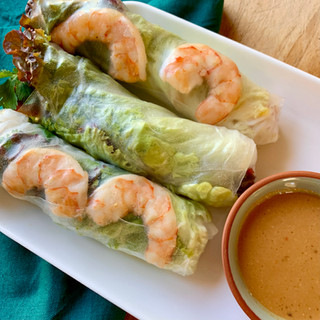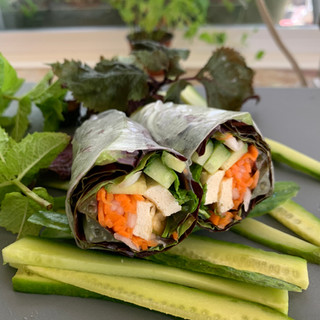Low sodium spring rolls with peanut chili dipping sauce
- Thuy
- Jun 14, 2021
- 4 min read
This is a recipe for low sodium peanut chili dipping sauce, with tips and suggestions for spring rolls. Spring rolls are one of my favorite foods, but the wrappers alone can be really high in sodium. I found one brand that has about 15 mg per wrapper, so every now and then we'll splurge and make a few spring rolls. The fillings are infinitely adaptable to whatever dietary restrictions you're dealing with. Go with tofu or just veggies for the lowest sodium option, beef or pork for a little more sodium, or splurge a little and use shrimp! Just one shrimp cut in half adds quite a bit of flavor.

Servings: Makes about 3/4 cup of sauce Sodium: less than 5 mg per tablespoon Time: 45 minutes
Peanut chili dipping sauce:
2 tablespoons unsalted peanut butter
2 tablespoons hot water
2 tablespoons chili garlic sauce
2 tablespoons unseasoned rice vinegar
2 teaspoons sugar
1/2 teaspoon onion powder
1 tablespoon soy sauce substitute
4 cloves garlic, minced or pressed
1 tablespoon balsamic vinegar
Notes re sauce ingredients: This recipe is really, really flexible. Start with unsalted peanut butter and hot water so you get a nice smooth consistency, and then just add everything else to taste! Red wine vinegar or lemon or lime juice are all good additions or substitutes for rice vinegar. My chili garlic sauce is a chunky red or green sauce, similar to samba oelek. Use whatever chili sauce fits into your diet. I use my soy sauce substitute which has less than 5 mg of sodium per tablespoon, but use whatever fits into your diet. If you're using store bought low sodium soy sauce or coconut aminos, start with just a teaspoon and thin out the sauce with more water if necessary. Traditional spring roll dipping sauce has hoison sauce, which has too much sodium for us. But if you have room for the 75 mg per teaspoon of sodium that it would add, go for it! Tahini or almond butter are great alternatives if peanut butter doesn’t work for you.
1) For the sauce, stir together peanut butter and hot water until it forms a smooth paste. Then add the remaining ingredients and stir to combine. Sauce can be refrigerated for about 3-5 days.
2) Find wrappers and choose the right ingredients:
The wrapper: choose the lowest sodium wrapper you can find. I happen to love this "OK" brand and it's also the lowest sodium wrapper I've found. The texture and flavor are great and it's about 15 mg of sodium per wrapper.
Shrimp is also very high in sodium but Whole Foods carries this Gulf Wild White Shrimp that has 135 mg of sodium for every 4 ounces (that's about 5 shrimp, so really not that many). This is the lowest I've ever seen and these shrimp are really tasty. Here is an interesting article I found about the sodium in shrimp. Shrimp and boiled pork is a very traditional filling. I also love beef, sliced thin and sautéed in butter. Tofu and chicken breast are two great low sodium options for fillings. You’ll want about 1 ounce of protein per roll.
Other possible fillings: vermicelli rice noodles (bun), cucumbers, lettuce (choose one that is soft and easy to wrap, like red leaf lettuce), pickled daikon and/or carrots, bell peppers, herbs including cilantro, mint, basil, shiso, bean sprouts, sliced pineapple, sliced green apples, or really anything you like to eat. Find a balance of crunchy, sweet, pickled, and a generous blend of herbs.
Tofu spring rolls are one of my favorite low sodium options. If I can get fresh tofu, I love to fry it. Rinse and pat the tofu dry, then cut into 1/4 inch slices and fry in about 350°F oil for about 1-2 minutes per side. Drain the fried pieces on a paper towel, and slice into thin pieces for wrapping. You can make the fried tofu in advance and reheat and slice before serving.
If you want to keep it healthier, sauté the tofu in just a little oil! I've tried frying the tofu that comes in the plastic containers and keep for months but it never crisps up nicely unless it's battered with some cornstarch or flour, which I've never tried. One downside with fresh tofu is that it goes bad quickly. If you aren't going to use it the day you buy it, remove the wrapping, rinse, and store the tofu in a large container completely submerged in water. Change the water daily and the tofu will stay fresh much longer (although don't push it, try to use it within a week).
3) Assemble each spring roll: dip the wrapper in simmering water and shake off any excess water. I leave a shallow pan with water simmering on the stove to dip the wrappers. Then lay the dipped wrapper on a flat plate or surface and let it sit until soft enough to roll. You don't have to soak the wrappers, and you shouldn't because they'll get soggy, just dip them in and out of the simmering water and make sure you shake off any extra water!
After many, many, many years of eating a lot of spring rolls, here's how I like to wrap them. Start with a broad leaf of lettuce, lay it to one side of the wrapper in the middle (not centered, because I leave one end open, and seal the other end). Pile the remaining ingredients neatly on top of the lettuce. If you want the shrimps to show through the wrapper then tuck them in under the lettuce. My mother cares about things like this. I don't, but for this photo I properly tucked the shrimp in. I also cut the shrimp in half so they're easier to roll. Then roll from the bottom, tuck in the closed end, and roll all the way to the top. Voila! Eat this right away because they'll stick to each other if they sit too long.
This is a meal I often ate with my family around a large table. We'd have a bowl of hot water on the table, all the fixings laid out, and everybody would wrap their own rolls and you'd eat as you go. We would even have a portable skillet in the middle of the table and cook the shrimp and beef right there. It's a really messy meal and your whole house will smell of meat but it's so fun and delicious.
















































